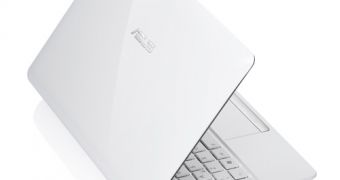Netbooks may have been selling less and less because of the tablet market, but they are far from through, especially now that AMD is challenging Intel on the mobile front by scoring design winds like ASUS' Eee PC 1015B and 1215B netbooks.
Makers of laptops have been struck hard recently, what with the Intel 6-series chipset being defective and tablets cannibalizing netbook market share.
On the bright side, however, there are more platforms for such entry-level systems than before, now that AMD is shipping Fusion chips.
Speaking of APUs (accelerated processing units), three of them are used by ASUS's new Eee PC 1015B and Eee PC 1215B, with display sizes of 10.l and 12.1 inches, respectively.
The former is powered by the single-core C30 chips (1.2 GHz speed) or dual-core C50, while the latter has the 1.6 GHz E-350 (dual-core).
Additionally, the display of the 1015B has a native resolution of 1,024 x 600 pixels, while the 12.1-inch one supports the HD 1,366 x 768 pixel format.
Another difference between the new siblings is that the smaller one can last for up to 8.5 hours on a single, 6-cell battery charge, while the other one is limited to 7.5 hours (weaker 3-cell batteries are available as well, for 3.5/3 hours).
A final distinctive element is the amount of memory, which can be of up to 2 GB and 4 GB one the 1015B and 1215B, respectively.
Other than that, the netbooks have the same storage options (up to 500 GB HDD), 10/100 Ethernet, VGA, HDMI, WiFi and Bluetooth 2.1+EDR (or 3.0+HS).
Needless to say, simply by virtue of being powered by the Fusion technology (their chips have integrated DirectX 11 graphics), they should outperform most other types pf low-end mobile PCs out there, including Intel Atom ones, at least in terms of video and game performance.
Unfortunately, ASUS was definitely not very generous when it came to pricing and availability.

 14 DAY TRIAL //
14 DAY TRIAL //